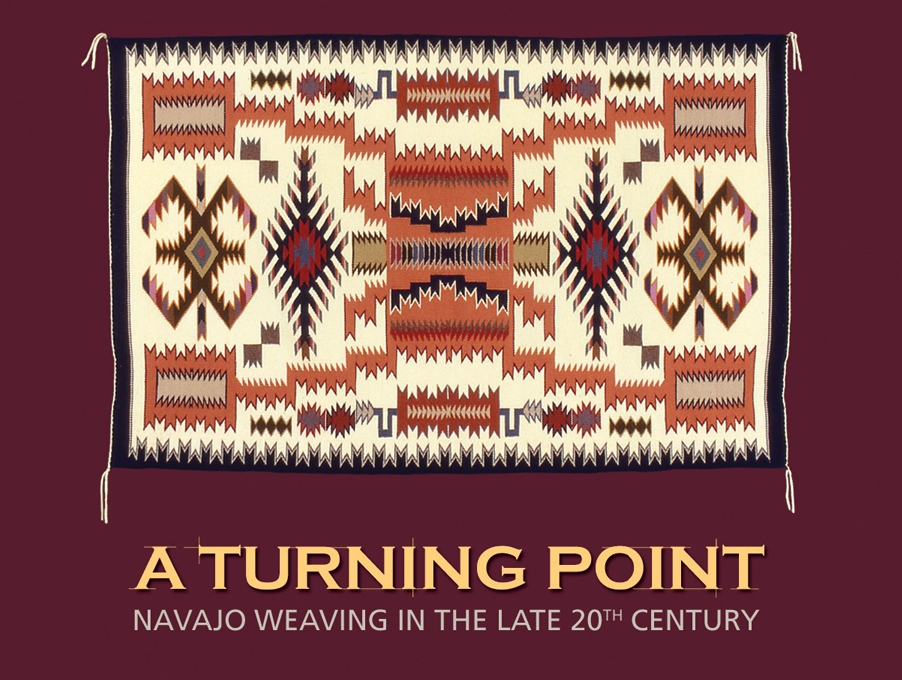
On Oct. 1, the University of Nebraska State Museum in Morrill Hall will open "A Turning Point: Navajo Weaving in the Late Twentieth Century," an exhibit showcasing modern Navajo textiles that reflect a culture balancing both tradition and change. The exhibit, shown in the Cooper Gallery, will coincide with the Textile Society of America’s 12th Biennial Symposium Oct. 6-9 in Lincoln. It will remain on display through Nov. 30.
"A Turning Point: Navajo Weaving in the Late Twentieth Century" features work by thirty-two contemporary Navajo weavers from the renowned Santa Fe Collection. The Santa Fe Collection was generously provided by Dr. and Mrs. Charles Rimmer of Amarillo, Texas. The exhibit was curated by Ann Lane Hedlund, director of the Gloria F. Ross Tapestry Program and curator of ethnology at the Arizona State Museum in Tucson, Arizona. More than 30 handwoven rugs and tapestries from the 1960s through 1980s will be on display reflecting many styles, including revival, sandpainting, pictorial, miniature, and sampler. Regional variations from the American Southwest are also represented, from Ganado to Teec Nos Pos and from Tuba City to Two Grey Hills.
The exhibit explores the changing artistic perceptions held by weavers, collectors, dealers and others, as Native American textiles moved from being viewed as traditional craft to fine art. The phrase “turning point” does not reference a specific person or event, but rather the complex cultural shift that emerged in the late 20th century as Navajo weavers began to self-identify as artists and extended their creative expressions beyond their tribal heritage. Guided by interpretive panels, museum visitors will discover the rise of the individual Navajo artists, as well as how handwoven artwork once seen as anonymously-made curios, trade goods, and home furnishings came to represent artistic mastery and museum-quality investments rich with beauty and cultural meaning.
Educational programming will be presented at Morrill Hall in support of the exhibit throughout the fall.
During regular museum hours Oct. 7-9, Native American weavers will demonstrate their craft outside the Cooper Gallery. Artists Martha Schultz, Melissa Cody, and Lola Cody, representing three generations of one Navajo family based in Arizona, will interact with visitors and show them the process of creating a handwoven tapestry first hand.
On Nov. 20, artist Mary Zicafoose will give a demonstration on tapestry weaving outside the Cooper Gallery from 11 a.m.-1 p.m. Visitors will have the opportunity to weave on a loom with assistance from Zicafoose.
Regular museum admission will be charged to attend these events.
This exhibition was made possible by generous support from the Cooper Foundation. Additional support was provided by the Gloria F. Ross Foundation, Gloria F. Ross Tapestry Program, Heard Museum, University of Nebraska State Museum, and Native American Public Telecommunications, Inc. It was curated by Ann Lane Hedlund, director of the Gloria F. Ross Tapestry Program and curator of ethnology at the Arizona State Museum in Tucson, Arizona. Organization of the exhibit was provided by UNL Textiles, Clothing, and Design professor Wendy Weiss, NU State Museum associate director Mark Harris, and artist Mary Zicafoose. The exhibit was designed by artists Caesar Chaves and Carly Stevens of the Heard Museum, installed by NU State Museum exhibit specialists Joel Nielsen and Ron Pike, and prepared by artist Sharon Vandenack and various volunteers. Educational programming was coordinated by UNL Textiles, Clothing, and Design lecturer Michael Burton, NU State Museum education coordinator Kathy French, and Lincoln Public Schools visual art curriculum specialist Nancy Childs.
The Textile Society of America’s 12th Biennial Symposium “Textiles and Settlement: From Plains Space to Cyber Space” will take place Oct. 6-9 in Lincoln. The international biennial event is hosted by the University of Nebraska-Lincoln Department of Textiles, Clothing, and Design. More than 100 textile and fiber art presentations, exhibitions, and workshops will be held in Lincoln and Omaha for the enrichment of textiles scholars, artists, professionals, and enthusiasts.
The University of Nebraska State Museum in Morrill Hall is open 9:30 a.m. to 4:30 p.m. Monday-Wednesday and Friday-Saturday, 9:30 a.m.-8 p.m. Thursdays, and 1:30-4:30 p.m. Sundays. Admission is $5 for adults (19 and over), $3 for children (5-18 years, 4 and under are free), and $10 for families (up to two adults and children). UNL staff, faculty and students are admitted free with valid NU ID. There is an additional charge for planetarium shows. Parking is free. For further information, telephone the museum at (402) 472-3779, visit its Web site or Mueller Planetarium's Web site, http://www.spacelaser.com, or contact Dana Ludvik, public relations coordinator, at (402) 472-3779 or dludvik2@unl.edu.
More details at: http://go.unl.edu/6cq